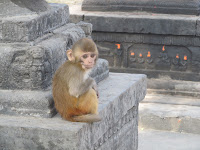 |
| The roads are narrow, the mountains steep, and the busses old |
The drive to Chitwan from Pokhara was
accomplished with a mid-size tourist bus that was guided by a water nymph
painted on the front and the words "speed control" painted on the bumper to
remind the driver not to drive too crazily. For some reason this driver seemed to
obey the bumper because he wasn’t pretending to be a race car driver and he
also didn’t see the point of passing the slower vehicles and chancing a head on
collision with the oncoming traffic.
 |
| We were lucky to arrive at Chitwan during Elephant Race time |
Arriving safely in Chitwan, we were driven to
our hotel to get settled in for our three day, two night stay. We could hear
something happening down the street so we walked along the river to arrive at
an empty elephant race track. We just missed the last race and the elephants
were leaving for the night. We snapped a few photos of these precious animals
lumbering on and away down the streets. And then we headed back to our hotel.
After receiving our itinerary from our gracious
hosts we gobbled up some delicious food and went to bed because we were going
to be waking up at 6am for our jungle adventure.
BEEP, BEEP, BEEP, BARK, BARK, BARK! Was the
symphony we fell asleep to. 6am came quickly and after lots of yawning and
stretching and a delicious breakfast we set off to explore the national park
with our guide Santa.
 |
| Elephant labour laws are not enforced in Nepal. |
 |
| The first of about 15 crocs we saw sunning themselves on the bank |
All the other tourists were taking elephant
rides but we told Santa that we didn’t feel right doing this because the riding
apparatus hurts the elephant’s back. It is also not good for them to carry so
many people at one time every day for their entire lives. Poor elephants! So
Santa put us on a canoe ride and then showed us the elephant breeding farm
where they breed more elephants to carry heavy tourists around. After the
breeding centre we went on a fun jungle walk where Katt insisted on lagging
behind to take photos until she was almost eaten by an invisible, imaginary,
and frightening tiger. I kept on telling her to hurry up because our guide was
walking really fast ahead of us but she wanted to take a picture of every
single butterfly and flower that she saw.
 |
| Canoeing along |
We then went back to the hotel and had a
tasty lunch; after lunch it was time for our jungle jeep adventure! At first we
sat nicely on the seats like good tourists as our jungle jeep adventure guide
stood on the bumper watching for tigers, but eventually the bumping made our
butts sore and we wanted to watch for tigers too, so we stood up. The jungle
jeep adventure trail consists of a dry mud track, very rutted and rocky, with
lots of log bridges to cross, and the jungle jeep was made without any shock
absorbers, so it was a bumpy ride.
 |
| Jungle Adventure Jeeps |
 |
| Mmmmm, leaves..... munch munch munch munch..... munch. |
After
about two hours of holding on for dear life in the open back of the jeep, the
door being held closed by a piece of twine and some telephone wire for
additional safety, we finally spotted our first jungle creature – an asian
rhino! He (or she) was huge and just standing by the trail munching on some delicious
green leaves. He did not seem to care that there was a jeep full of tourists
snapping photos of him and he continued his lunch unperturbed until we finally
had to leave. We also saw some of the 1500 armed guards that protect the park
and the animals from poachers from India and other opportunistic scum. There
were monkeys in the trees and lots of pretty birds but we were not lucky enough
to see a tiger, an elephant, or a yeti.







































